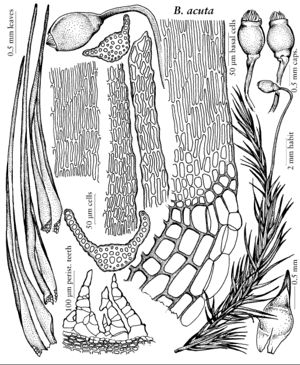Difference between revisions of "Blindia acuta"
Bryol. Europ. 2: 19. 1846,.
FNA>Volume Importer |
FNA>Volume Importer |
||
| Line 24: | Line 24: | ||
|elevation=low to high elevations (0-3000 m) | |elevation=low to high elevations (0-3000 m) | ||
|distribution=Greenland;Alta.;B.C.;N.B.;Nfld. and Labr. (Nfld.);N.W.T.;N.S.;Nunavut;Ont.;Que.;Yukon;Alaska;Calif.;Colo.;Mich.;Minn.;Mont.;N.H.;N.Y.;N.C.;Oreg.;Pa.;Tenn.;Vt.;Wash.;Wyo.;Central America (Guatemala);Europe;Asia;Africa;Atlantic Islands (Iceland). | |distribution=Greenland;Alta.;B.C.;N.B.;Nfld. and Labr. (Nfld.);N.W.T.;N.S.;Nunavut;Ont.;Que.;Yukon;Alaska;Calif.;Colo.;Mich.;Minn.;Mont.;N.H.;N.Y.;N.C.;Oreg.;Pa.;Tenn.;Vt.;Wash.;Wyo.;Central America (Guatemala);Europe;Asia;Africa;Atlantic Islands (Iceland). | ||
| − | |discussion=<p>Blindia acuta forms soft blackish mats on acidic rocks in moist arctic, alpine, and montane habitats. The well-developed alar cells, smooth leaf cells, subulate leaves, and short-ovate, smooth capsules with well-developed, smooth peristome teeth are distinguishing features. Seligeria species are smaller and occur on calcareous rocks.</p> | + | |discussion=<p><i>Blindia acuta</i> forms soft blackish mats on acidic rocks in moist arctic, alpine, and montane habitats. The well-developed alar cells, smooth leaf cells, subulate leaves, and short-ovate, smooth capsules with well-developed, smooth peristome teeth are distinguishing features. <i>Seligeria</i> species are smaller and occur on calcareous rocks.</p> |
|tables= | |tables= | ||
|references= | |references= | ||
| Line 47: | Line 47: | ||
|publication year= | |publication year= | ||
|special status= | |special status= | ||
| − | |source xml=https://jpend@bitbucket.org/aafc-mbb/fna-data-curation.git/src/ | + | |source xml=https://jpend@bitbucket.org/aafc-mbb/fna-data-curation.git/src/8f726806613d60c220dc4493de13607dd3150896/coarse_grained_fna_xml/V27/V27_453.xml |
|genus=Blindia | |genus=Blindia | ||
|species=Blindia acuta | |species=Blindia acuta | ||
Revision as of 17:55, 18 September 2019
Plants often blackish or dark brown, sometimes olive green. Leaves secund to often deciduous, lanceolate-subulate, obtuse, costae filling subula; margins denticulate at apex, entire below, leaf cells (1–)3:1, quadrate to rectangular-elliptic; perichaetial leaves abruptly subulate. Seta 3–13 mm, flexuose. Capsule ovate to narrowly pyriform, peristome of 16, lanceolate teeth; columella not developed. Spores 13–20 µm.
Habitat: Moist or dripping acidic rock faces, most common in montane/alpine habitats
Elevation: low to high elevations (0-3000 m)
Distribution
Greenland, Alta., B.C., N.B., Nfld. and Labr. (Nfld.), N.W.T., N.S., Nunavut, Ont., Que., Yukon, Alaska, Calif., Colo., Mich., Minn., Mont., N.H., N.Y., N.C., Oreg., Pa., Tenn., Vt., Wash., Wyo., Central America (Guatemala), Europe, Asia, Africa, Atlantic Islands (Iceland).
Discussion
Blindia acuta forms soft blackish mats on acidic rocks in moist arctic, alpine, and montane habitats. The well-developed alar cells, smooth leaf cells, subulate leaves, and short-ovate, smooth capsules with well-developed, smooth peristome teeth are distinguishing features. Seligeria species are smaller and occur on calcareous rocks.
Selected References
None.
